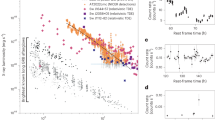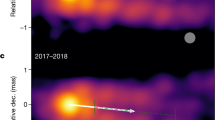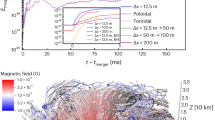Abstract
M87 has been the target of numerous astronomical observations across the electromagnetic spectrum, and very long baseline interferometry has resolved an edge-brightened jet1,2,3,4. However, the origin and formation of its jets remain unclear. In our current understanding, black holes (BH) are the driving engine of jet formation5, and indeed the recent Event Horizon Telescope observations revealed a ring-like structure in agreement with theoretical models of accretion onto a rotating Kerr BH6. In addition to the spin of the BH being a potential source of energy for the launching mechanism, magnetic fields are believed to play a key role in the formation of relativistic jets7,8. A priori, the spin, a⋆, of the BH in M87⋆ is unknown; however, when accounting for the estimates of the X-ray luminosity and jet power, values of \(\left|{a}_{\star }\right|\gtrsim 0.5\) appear favoured6. Besides the properties of the accretion flow and the BH spin, the radiation microphysics including the particle distribution (thermal6 and non-thermal9,10) as well as the particle acceleration mechanism11 play a crucial role. We show that general relativistic magnetohydrodynamic simulations and general relativistic radiative transfer calculations can reproduce the broadband spectrum from the radio to the near-infrared regime and simultaneously match the observed collimation profile of M87, thus allowing us to set rough constraints on the dimensionless spin of M87* to be 0.5 ≲ a⋆ ≲ 1.0, with higher spins being possibly favoured.
This is a preview of subscription content, access via your institution
Access options
Access Nature and 54 other Nature Portfolio journals
Get Nature+, our best-value online-access subscription
$29.99 / 30 days
cancel any time
Subscribe to this journal
Receive 12 digital issues and online access to articles
$119.00 per year
only $9.92 per issue
Buy this article
- Purchase on Springer Link
- Instant access to full article PDF
Prices may be subject to local taxes which are calculated during checkout




Similar content being viewed by others
Data availability
The data that support the plots within this paper and other findings of this study are available from the corresponding authors upon reasonable request.
Code availability
The publicly released version of the GRMHD code BHAC can be found at https://bhac.science. The eht-imaging software to convolve the images is available at repository https://github.com/achael/eht-imaging.
References
Kovalev, Y. Y., Lister, M. L., Homan, D. C. & Kellermann, K. I. The inner jet of the radio galaxy M87. Astrophys. J. Lett. 668, L27–L30 (2007).
Asada, K. & Nakamura, M. The structure of the M87 jet: a transition from parabolic to conical streamlines. Astrophys. J. Lett. 745, L28 (2012).
Walker, R. C., Hardee, P. E., Davies, F. B., Ly, C. & Junor, W. The structure and dynamics of the subparsec jet in M87 based on 50 VLBA observations over 17 years at 43 GHz. Astrophys. J. 855, 128 (2018).
Kim, J.-Y. et al. The limb-brightened jet of M87 down to the 7 Schwarzschild radii scale. Astron. Astrophys. 616, A188 (2018).
Blandford, R. D. & Znajek, R. L. Electromagnetic extraction of energy from Kerr black holes. Mon. Not. R. Astron. Soc. 179, 433–456 (1977).
Event Horizon Telescope Collaboration et al. First M87 Event Horizon Telescope results. V. Physical origin of the asymmetric ring. Astrophys. J. Lett. 875, L5 (2019).
Narayan, R., Igumenshchev, I. V. & Abramowicz, M. A. Magnetically arrested disk: an energetically efficient accretion flow. Publ. Astron. Soc. Jpn 55, L69–L72 (2003).
Narayan, R., Sa̧dowski, A., Penna, R. F. & Kulkarni, A. K. GRMHD simulations of magnetized advection-dominated accretion on a non-spinning black hole: role of outflows. Mon. Not. R. Astron. Soc. 426, 3241–3259 (2012).
Kim, J.-Y. et al. Long-term millimeter VLBI monitoring of M 87 with KVN at milliarcsecond resolution: nuclear spectrum. Astron. Astrophys. 610, L5 (2018).
Junor, W. & Biretta, J. A. The radio jet in 3C274 at 0.01 pc resolution. Astron. J. 109, 500–506 (1995).
Ball, D., Sironi, L. & Özel, F. Electron and proton acceleration in trans-relativistic magnetic reconnection: dependence on plasma beta and magnetization. Astrophys. J. 862, 80 (2018).
Xiao, F. Modelling energetic particles by a relativistic kappa-loss-cone distribution function in plasmas. Plasma Phys. Control. Fusion 48, 203–213 (2006).
Davelaar, J. et al. Modeling non-thermal emission from the jet-launching region of M 87 with adaptive mesh refinement. Astron. Astrophys. 632, A2 (2019).
Mizuno, Y. et al. Comparison of the ion-to-electron temperature ratio prescription: GRMHD simulations with electron thermodynamics. Mon. Not. R. Astron. Soc. 506, 741–758 (2021).
Younsi, Z., Porth, O., Mizuno, Y., Fromm, C. M. & Olivares, H. Modelling the polarised emission from black holes on event horizon-scales. In Proc. International Astronomical Union, Symposium S342, Perseus in Sicily: From Black Hole to Cluster Outskirts Vol. 14 (eds Asada, K. et al.) 9–12 (Cambridge Univ. Press, 2020).
Mościbrodzka, M., Falcke, H., Shiokawa, H. & Gammie, C. F. Observational appearance of inefficient accretion flows and jets in 3D GRMHD simulations: application to Sagittarius A*. Astron. Astrophys. 570, A7 (2014).
Doeleman, S. S. et al. Jet-launching structure resolved near the supermassive black hole in M87. Science 338, 355–358 (2012).
Perlman, E. S. et al. Deep 10 micron imaging of M87. Astrophys. J. 561, L51–L54 (2001).
Lonsdale, C. J., Doeleman, S. S. & Phillips, R. B. A 3 millimeter VLBI continuum source survey. Astron. J. 116, 8–12 (1998).
Whysong, D. & Antonucci, R. Thermal emission as a test for hidden nuclei in nearby radio galaxies. Astrophys. J. 602, 116–122 (2004).
Akiyama, K. et al. 230 GHz VLBI observations of M87: event-horizon-scale structure during an enhanced very-high-energy γ-ray state in 2012. Astrophys. J. 807, 150 (2015).
Prieto, M. A., Fernández-Ontiveros, J. A., Markoff, S., Espada, D. & González-Martín, O. The central parsecs of M87: jet emission and an elusive accretion disc. Mon. Not. R. Astron. Soc. 457, 3801–3816 (2016).
Hada, K. et al. Pilot KaVA monitoring on the M 87 jet: confirming the inner jet structure and superluminal motions at sub-pc scales. Publ. Astron. Soc. Jpn 69, 71 (2017).
An, T., Sohn, B. W. & Imai, H. Capabilities and prospects of the East Asia Very Long Baseline Interferometry Network. Nat. Astron. 2, 118–125 (2018).
Lister, M. L. et al. MOJAVE. XV. VLBA 15 GHz total intensity and polarization maps of 437 parsec-scale AGN jets from 1996 to 2017. Astrophys. J. Suppl. Ser. 234, 12 (2018).
Nakamura, M. et al. Parabolic jets from the spinning black hole in M87. Astrophys. J. 868, 146 (2018).
Mizuno, Y. et al. The current ability to test theories of gravity with black hole shadows. Nat. Astron. 2, 585–590 (2018).
Porth, O. et al. The black hole accretion code. Comput. Astrophys. Cosmol. 4, 1 (2017).
Rezzolla, L & Zanotti, O. Relativistic Hydrodynamics (Oxford Univ. Press, 2013).
Olivares, H. et al. Constrained transport and adaptive mesh refinement in the Black Hole Accretion Code. Astron. Astrophys. 629, A61 (2019).
Font, J. A. & Daigne, F. On the stability of thick accretion disks around black holes. Astrophys. J. 581, L23–L26 (2002).
Shiokawa, H., Dolence, J. C., Gammie, C. F. & Noble, S. C. Global general relativistic magnetohydrodynamic simulations of black hole accretion flows: a convergence study. Astrophys. J. 744, 187 (2012).
Gold, R. et al. Verification of radiative transfer schemes for the EHT. Astrophys. J. 897, 148 (2020).
Younsi, Z., Wu, K. & Fuerst, S. V. General relativistic radiative transfer: formulation and emission from structured tori around black holes. Astron. Astrophys. 545, A13 (2012).
Event Horizon Telescope Collaborationet al. First M87 Event Horizon Telescope results. I. The shadow of the supermassive black hole. Astrophys. J. Lett. 875, L1 (2019).
Mościbrodzka, M., Gammie, C. F., Dolence, J. C., Shiokawa, H. & Leung, P. K. Radiative models of SGR A* from GRMHD simulations. Astrophys. J. 706, 497–507 (2009).
Chael, A., Narayan, R. & Johnson, M. D. Two-temperature, Magnetically Arrested Disc simulations of the jet from the supermassive black hole in M87. Mon. Not. R. Astron. Soc. 486, 2873–2895 (2019).
Nemmen, R. The spin of M87*. Astrophys. J. Lett. 880, L26 (2019).
Feng, J. & Wu, Q. Constraint on the black hole spin of M87 from the accretion-jet model. Mon. Not. R. Astron. Soc. 470, 612–616 (2017).
Event Horizon Telescope Collaborationet al. First M87 Event Horizon Telescope results. VII. Polarization of the ring. Astrophys. J. Lett. 910, L12 (2021).
Event Horizon Telescope Collaborationet al. First M87 Event Horizon Telescope results. VIII. Magnetic field structure near the event horizon. Astrophys. J. Lett. 910, L13 (2021).
Mertens, F., Lobanov, A. P., Walker, R. C. & Hardee, P. E. Kinematics of the jet in M 87 on scales of 100–1000 Schwarzschild radii. Astron. Astrophys. 595, A54 (2016).
Acknowledgements
This research is supported by the ERC synergy grant ‘BlackHoleCam: Imaging the Event Horizon of Black Holes’ (grant no. 610058). C.M.F. is supported by the Black Hole Initiative at Harvard University, which is supported by a grant from the John Templeton Foundation. A.N. was supported by the Hellenic Foundation for Research and Innovation (H.F.R.I.) under the ‘2nd Call for H.F.R.I. Research Projects to support Post-Doctoral Researchers’ (project no. 00634). Z.Y. is supported by a UK Research and Innovation Stephen Hawking Fellowship and acknowledges support from a Leverhulme Trust Early Career Fellowship. J.D. is supported by NASA grant no. NNX17AL82 and a Joint Columbia/Flatiron Postdoctoral Fellowship. Research at the Flatiron Institute is supported by the Simons Foundation. The simulations were performed on Goethe-HLR at the Center for Scientific Computing in Frankfurt, on Iboga at the Institut für Theoretische Physik in Frankfurt, and on Pi2.0 at Shanghai Jiao Tong University.
Author information
Authors and Affiliations
Contributions
A.C.-O. and C.M.F. performed and analysed the GRRT calculations and wrote the manuscript. Y.M. performed the GRMHD simulations and wrote the manuscript. A.N. wrote the manuscript. Z.Y. authored the GRRT code BHOSS. O.P. authored the GRMHD code BHAC. J.D. helped in the GRRT calculations. H.F. and M.K. wrote the manuscript. L.R. wrote the manuscript and coordinated the various aspects of the research. All authors discussed the results and commented on all versions of the manuscript.
Corresponding authors
Ethics declarations
Competing interests
The authors declare no competing interests.
Additional information
Peer review information Nature Astronomy thanks Bidisha Bandyopadhyay and the other, anonymous, reviewer(s) for their contribution to the peer review of this work.
Publisher’s note Springer Nature remains neutral with regard to jurisdictional claims in published maps and institutional affiliations.
Extended data
Extended Data Fig. 1 Large-scale morphology of the jet from GRMHD simulations of a Kerr BH with spin a⋆ = 0.9375 (the BH spin is aligned with the z axis).
a) Shown the magnetisation parameters σ, b) the dimensionless electron temperature Θe, c) the distribution of the power-law index κ, and d) the weighted temperature w. All quantities are averaged in space (over the azimuthal direction) and in time (over a time interval of 2,000 M with a cadence of 10 M). The white dashed line marks the boundary between bounded and unbounded (Be > 1.02) material, while the black lines show the most important contours of the logarithm of the magnetisation, \({{{\mathrm{log}}}\,}_{10}\sigma =-1.0,\,0.0\), and 0.5. Moving out from the polar axis, we report the contours for the ‘jet spine’, the ‘jet sheath’, and the ‘external wall’.
Extended Data Fig. 2 Small-scale morphology of the jet from GRMHD simulations.
Same as in Extended Data Fig. 1, Kerr BH with spin a⋆ = 0.9375 but on smaller lengthscales.
Extended Data Fig. 3 Same as in Fig. 2, but considering five different values of the black hole spin.
Solid and dotted lines represent nonthermal and thermal emission models, respectively. While gray vertical lines show the most representative frequencies. For each observational data, the uncertainties indicate the variability during the observations.
Extended Data Fig. 4 GRRT and convolved images.
The top panels shown the GRRT, while bottom shown convolved images for thermal and nonthermal emission models for two BHs with spins a⋆= 0.50 and a⋆= 0.9375. The images refer to a representative time (t = 13, 820 M) and we show as an ellipse in the lower-left corner the convolving beam with axes 116 × 307 μas, as in the observational data. The contours in the flux density correspond to \({S}_{i}={S}_{{{{\rm{m}}}}in}+0.43\ {{{\rm{m}}}}Jy\times {\sqrt{2}}^{i}\), where i = 0, 1, …, n, such that Sn < Smax.
Extended Data Fig. 5 Same as in Extended Data Figure 4, but showing the time average computed between 13,000 M and 15,000 M.
Note that all of the features discussed in Fig. Extended Data Figure 4 are present also when averaging in time.
Extended Data Fig. 6 χ2 for the jet width.
χ2 between the observational data and the jet width measured from the numerical simulations (see Fig. 4).
Rights and permissions
About this article
Cite this article
Cruz-Osorio, A., Fromm, C.M., Mizuno, Y. et al. State-of-the-art energetic and morphological modelling of the launching site of the M87 jet. Nat Astron 6, 103–108 (2022). https://doi.org/10.1038/s41550-021-01506-w
Received:
Accepted:
Published:
Issue Date:
DOI: https://doi.org/10.1038/s41550-021-01506-w
This article is cited by
-
Precessing jet nozzle connecting to a spinning black hole in M87
Nature (2023)
-
Stringent axion constraints with Event Horizon Telescope polarimetric measurements of M87⋆
Nature Astronomy (2022)
-
Jet launching of M87
Nature Astronomy (2021)



